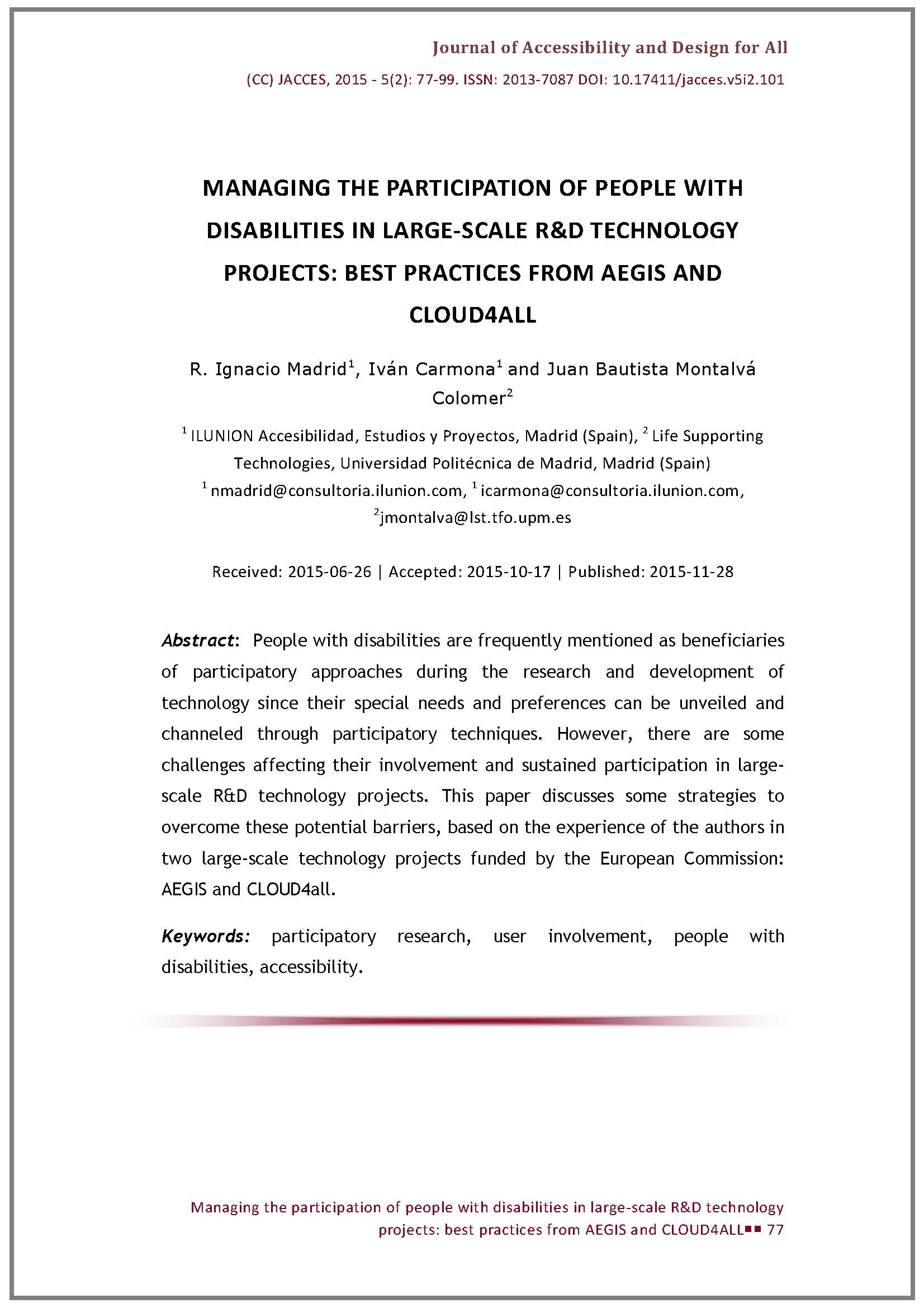MANAGING THE PARTICIPATION OF PEOPLE WITH DISABILITIES IN LARGE-SCALE R&D TECHNOLOGY PROJECTS: BEST PRACTICES FROM AEGIS AND CLOUD4ALL
DOI:
https://doi.org/10.17411/jacces.v5i2.101Keywords:
Participatory research, User management, AccessibilityAbstract
People with disabilities are frequently mentioned as beneficiaries of participatory approaches during the research and development of technology, since their special needs and preferences can be unveiled and channeled through participatory techniques. However, there are some challenges affecting their involvement and sustained participation in large-scale R&D technology projects. This paper discusses some strategies to overcome these potential barriers, based on the experience of the authors in two large-scale technology projects funded by the European Commission: AEGIS and CLOUD4all.References
Aldred, R. (2008). Ethical and political issues in contemporary research relationships. Sociology, 42 (5), 887-903.
Ashok, M., & Jacko, J. A. (2009). Dimensions of user diversity. In C. Stephanidis, The universal access handbook, pp. 1-15. Philadelphia: Taylor & Francis.
Barnes, C. (2003). What a difference a decade makes: Reflections on doing ‘Emancipatory’ disability research. Disability & Society, 18 (1), 3-17.
Carmona, I., Azpiroz, J., Scheuhammer, J., Welche, P. & van Isacker, K. (2010). AEGIS 2nd User forum meetings proceedings. Retrieved 25 June, 2015 from http://www.aegis-project.eu/images/docs/ID5.3.2_User_forum_v4.pdf
De Couvreur,L. & Goossens, R. (2011). Design for (every)one: co-creation as a bridge between universal design and rehabilitation engineering. CoDesign: International Journal of CoCreation in Design and the Arts, 7 (2), 107-121.
Gemou, M. & Bekiaris, E. (2010). From User Modelling to Iterative Design and Development: The AEGIS IP UCD Approach. In N. González, A. Kämäräinen, O. Kalla & I. Vélez (Eds.), Tangible Information Technology for a Better Ageing Society, pp.31-44. Jyväskylä: AGORA Center.
Gregor, P., Sloan, D., & Newell, A. F. (2005). Disability and technology: building barriers or creating opportunities?. Advances in computers, 64, 283-346.
Holone, H., & Herstad, J. (2013). Three tensions in participatory design for inclusion. In W. Mackay et al. (Eds.), Proceedings of the SIGCHI Conference on Human Factors in Computing Systems, pp. 2903-2906. New York: ACM.
Kitchin, R. (2000). The researched opinions on research: disabled people and disability research. Disability & Society, 15 (1), 25-47.
Korn, P., Bekiaris, E., & Gemou, M. (2009). Towards open access accessibility everywhere: The ÆGIS concept. In C. Stephanidis (Ed.), Universal Access in Human-Computer Interaction. Addressing Diversity (pp. 535-543). Berlin: Springer Berlin Heidelberg.
Macdonald, S. J. & Clayton, J. (2013). Back to the future, disability and the digital divide. Disability & Society, 28 (5), 702-718.
Munteanu,C., Molyneaux, H., & O’Donnell, S. (2004). Vulnerable populations. Ethical implications for human computer interaction research. Interactions, 21 (1), 50-53.
Muller, M.J. (2009). Participatory design: The third space in HCI. In A. Sears and J. Jacko (Eds.), Human computer interaction: Development process, 165-186. Florida: CRC Press.
Ortega-Moral, M., Peinado, I., & Vanderheiden, G. C. (2014). Cloud4all: Scope, Evolution and Challenges. In C. Stephanidis and M. Antona (Eds.), Universal Access in Human-Computer Interaction. Design for All and Accessibility Practice (pp. 421-430). Cham, Switzerland: Springer International Publishing.
Sainz, F., & Bustamante, J. (2014). Aspectos éticos en la participación de personas con diversidad funcional en proyectos de investigación tecnológica. Revista Española de Discapacidad, 2 (1), 165-174.
Sainz, F., Turrero, M., González, L., & Madrid, R. I. (2014). Involucración de personas con discapacidad en proyectos tecnológicos de I+ D+ i: el caso de APSIS4all. Revista Española de Discapacidad, 2 (2), 121-144.
Sainz, F. et al. (2012). Deliverable D401.1: Cloud4all user population and UCD implementation plan. Retrieved June 19, 2015 from http://www.cloud4all.info/research/public-deliverables/d401-1-cloud4all-user-population-and-ucd-implementation-plan/
Slegers,K., Duysburgh,P., & Jacobs, A. (2010). Research methods for involving hearing impaired children in IT innovation. In A. Blandford, et al. (Eds.). NORDICHI 2010: Extending Boundaries. Proceedings of the Sixth Nordic Conference on Human-Computer Interaction (pp.769-772). New York, NY: ACM Press.
Slegers,K., Duysburgh,P., & Hendriks, N. (2015). CoDesign with people living with cognitive and sensory impairments. CoDesign: International Journal of CoCreation in Design and the Arts, 11 (1), 1-3.
TECH (Technosite), NOVA (Norwegian Social Research), & CNIPA (Italian National Center of Informatics in Public Administration) (2011). Monitoring eAccessibility in Europe: 2011 Annual Report. Retrieved March 6, 2014 from http://www.eaccessibility-monitoring.eu/researchResult.aspx.
Vines, J., McNaney, R., Lindsay, S., Wallace, J., & McCarthy, J. (2014). Designing for and with vulnerable people. Interactions, 21 (1), 44-46.
Walmsley, J., & Johnson K. (2003). Inclusive research with people with learning disabilities: Past, present and futures. London: Jessica Kingsley.

Downloads
Published
Issue
Section
License
- Authors retain copyright and grant the journal right of first publication with the work simultaneously licensed under a Creative Commons Attribution License that allows others to share or adapt the work with an acknowledgment of the work's authorship and initial publication in this journal. Use of the work for commercial purposes are not allowed.
- Authors are able to publish the journal's published version of the work in other media (e.g., post it to an institutional repository or publish it in a book), as far as they inform the Journal of Accessibility and Design for All of that fact. When publishing their work in other sources, authors must mention the name of the Journal of Accessibility and Design for All, its ISSN, the number and issue in which the article was published and a link to the main page of the Journal of Accessibility and Design for All. Optionally, they can also include a link to the article published in the Journal of Accessibility and Design for All.
- Authors are permitted and encouraged to post their work online (e.g., in institutional repositories or on their website), as it can lead to productive exchanges, as well as earlier and greater citation of published work.

